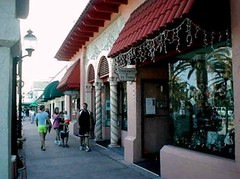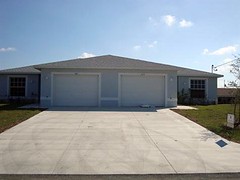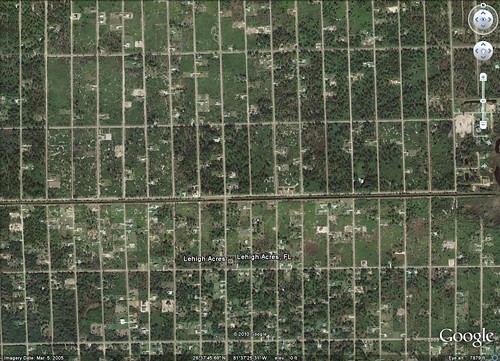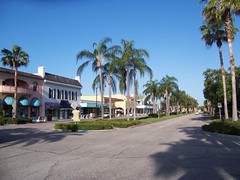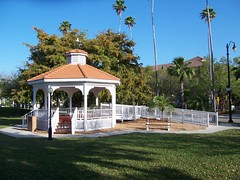A tale of two cities in Florida, where walkability trumps sprawl – again

Posted March 23, 2010 at 1:35PM
An upcoming PBS series on the future of Florida contrasts the two Sunshine State communities of Venice (above left) and Lehigh Acres (above right). Venice has a traditional town layout, with a highly walkable center, while Lehigh Acres is characterized by low-density, unfinished sprawl with no center at all. Venice is weathering the recession and real estate bust fairly well, but Lehigh Acres has one of the highest foreclosure rates in the country, writes Kim Hackett in the Sarasota Herald Tribune. (Venice is in Sarasota County.)
Emmy-award-winning filmmaker Spencer Briggs calls Venice “charming by design” and says the community “creates democracy because it’s walkable.” You can certainly see the stark difference in design between the two places in the two Google Earth images below. Venice is much more compact (over nine times the number of housing units per acre, according to census data) and oriented toward its center:
Writing in The New York Times in February 2009, Damien Cave called Lehigh Acres “the American dream in high reverse.” Cave reported that homes in the community had lost 80 percent of their peak value: “Crime is up, school enrollment is down, and one in four residents received food stamps in December [2008], nearly a fourfold increase since 2006.”
Cave suggested that there was reason to believe that the worst of the housing crisis in Lehigh Acres was past, but the real estate service Trulia reports that, since his article was written, the community has suffered another 25 percent decline in average sales price per square foot. As of last week, there were over 3000 homes for sale in Lehigh Acres, over half as a result of foreclosure.
Meanwhile, sales are on the increase in Venice, where prices did decline in the last year, but by less than two percent. 22 percent of the houses currently for sale in Venice are in some stage of foreclosure; that sounds like a lot until you consider that in Lehigh Acres the portion is 56 percent. Perhaps the most telling difference between the two is the average sale price per square foot, which in Venice is almost three times that in Lehigh Acres ($110 as opposed to $38).
Writing in the St. Petersburg Times in August 2009, Kris Hundley called Lehigh Acres “Florida’s lesson in unregulated growth.” 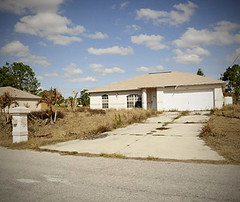 Hundley reports that the community was originally created in the 1960s as a get-rich-quick scheme and tax dodge for two partners looking to sell lots to Midwestern retirees, without much of a plan for actual development and no land reserved for schools, parks, or businesses. The half-acre lot sales were somewhat random, scattering the population. Today 55,000 people are said to reside in and around Lehigh Acres, “less than one person per acre, in a space the size of Orlando” (other estimates go as high as just over two persons per acre, by any measure still a very low density). There have been periods of robust sales and building, most recently from 2004-2006; but that only set the stage for a dramatic crash when the bubble burst.
Hundley reports that the community was originally created in the 1960s as a get-rich-quick scheme and tax dodge for two partners looking to sell lots to Midwestern retirees, without much of a plan for actual development and no land reserved for schools, parks, or businesses. The half-acre lot sales were somewhat random, scattering the population. Today 55,000 people are said to reside in and around Lehigh Acres, “less than one person per acre, in a space the size of Orlando” (other estimates go as high as just over two persons per acre, by any measure still a very low density). There have been periods of robust sales and building, most recently from 2004-2006; but that only set the stage for a dramatic crash when the bubble burst.
Hundley’s description is pretty grim:
“Under a huge summer sky, the sprawling community appears overexposed and abandoned. The main drag offers an endless loop of failed businesses and vacant strip centers, the only relief coming from the landscaping in the Wal-Mart parking lot.
“Turn off onto any of the cookie-cutter side streets and it's post-Apocalyptic America. Empty lot here, half-finished concrete shell of a house there, run down duplex for rent down the block. Unfinished condos have been torn down or boarded up by county crews.
“A new, eight-unit townhome project has two tenants, their homes the only ones with glass instead of wood where the windows should be . . .”
Venice, on the other hand, seems to be the kind of place that everyone likes. I’m sure the beach doesn’t hurt. (Lehigh Acres is a bit inland.) But there is no doubt that careful planning is a big part of the community's story: documentary producer Briggs told Hackett that, as designed by proto-new-urbanist planner John Nolen in a 1926 plan, Venice's walkability, parks and public spaces provide a template for how good communities should evolve. From Nolen’s Wikipedia entry:
“In Venice, Nolen effectively balanced his design between two transcendental ideals — civic virtue and Nature. From City Hall, one could view the palette of Nature while surrounded by the physical form of the ‘civic spirit.’ An ideal site for contemplation, a vision of Nature was always at hand, but it never remained the same, shifting with the tides and the seasons.
“Two diagonal avenues defined the neighborhoods lying between the Gulf and the Civic Center. School sites and the commercial center provided focal points for neighborhoods. Common greens and playgrounds were provided in each neighborhood . . .”
US News and World Report featured Venice as one of America’s best places to retire. David LaGesse writes: “Coming into downtown Venice, Fla., feels a bit like slipping back to an older America, where once thriving Main Streets sat at the center of quiet, walkable neighborhoods.” The program is scheduled to air in mid-May, at least in Florida, as one in a five-part series on lessons from the past as the state prepares for development after recession.
Thanks to Lisa Engstrom Nisenson for pointing me to Hackett's article.
